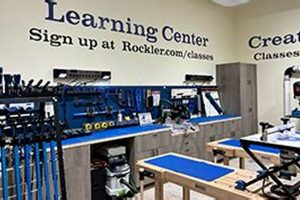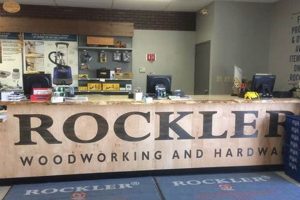This particular setup represents a stationary woodworking tool designed to enhance routing precision and efficiency. It integrates a router, typically mounted upside down beneath a flat surface, with a fence system to guide workpieces. This configuration allows for controlled material removal and the creation of consistent profiles on wood.
Utilizing this type of system provides several advantages. It increases safety by allowing the operator to keep their hands further from the router bit. It also improves the accuracy and repeatability of cuts, especially when producing multiple identical pieces. Furthermore, it contributes to workshop organization and workflow by providing a dedicated workspace for routing operations and drawing upon the heritage and established quality associated with Rockler Woodworking and Hardware.
The subsequent sections will delve into the specific features, accessories, and applications of a comprehensive routing workstation, detailing how it can be leveraged to achieve professional-grade woodworking results.
Essential Router Table Usage Guidance
The following points outline critical considerations for operating a stationary routing system effectively and safely.
Tip 1: Bit Selection: Choose router bits appropriate for the wood type and desired profile. Ensure bits are sharp and free from damage to prevent tear-out and ensure clean cuts.
Tip 2: Fence Adjustment: Fine-tune the fence position to control the depth of cut accurately. Use precise measuring tools to guarantee consistent results across multiple workpieces.
Tip 3: Feed Rate Management: Maintain a consistent feed rate, avoiding excessive force or hesitation. A smooth, steady feed prevents burning and improves the quality of the cut.
Tip 4: Dust Collection Implementation: Connect a dust collection system to minimize airborne particles and maintain a clean workspace. Adequate dust extraction improves visibility and reduces health risks.
Tip 5: Featherboard Utilization: Employ featherboards to hold the workpiece firmly against the fence and table surface. This enhances safety and improves cut accuracy by preventing movement during routing.
Tip 6: Test Cuts: Before routing the final workpiece, perform test cuts on scrap material. This allows for fine-tuning of the setup and validation of the desired profile.
Tip 7: Safety Gear Adherence: Always wear appropriate safety gear, including eye protection and hearing protection, when operating any power tool. Consistent use of safety equipment minimizes the risk of injury.
Adhering to these guidelines will improve the precision, safety, and overall quality of projects completed with a stationary routing system.
The subsequent sections will explore advanced techniques and troubleshooting strategies, building upon the foundational knowledge presented here.
1. Tabletop Material
The material composition of a router table’s surface directly impacts its performance and longevity. Within the context of equipment offered by Rockler Woodworking and Hardware, various materials are utilized, each exhibiting distinct characteristics suitable for different woodworking applications.
- Surface Flatness and Stability
The flatness of the tabletop material is paramount for consistent routing. Warping or inconsistencies can lead to uneven cuts and reduced accuracy. High-density materials such as phenolic resin or cast iron are chosen for their dimensional stability and resistance to deflection under load. This ensures consistent contact between the workpiece and the router bit. Rockler offers solutions like their cast iron router table tops, known for their inherent flatness and mass.
- Material Durability and Resistance to Wear
The tabletop surface is subjected to repeated contact with workpieces, clamps, and other tools. Materials like melamine-coated MDF, while more economical, may be prone to scratching and wear over time. More durable options, such as phenolic resin or composite materials, offer increased resistance to abrasion and impact, extending the lifespan of the router table. Rockler offers tabletop options with durable surfaces designed to withstand rigorous use.
- Coefficient of Friction
The surface friction of the tabletop influences the ease with which workpieces can be moved and manipulated during routing. Materials with a lower coefficient of friction allow for smoother gliding of the workpiece, reducing the risk of binding or jerky movements. The ideal material strikes a balance between smooth movement and sufficient grip to prevent unintentional slippage. Rockler’s phenolic resin surfaces offer this balance.
- Resistance to Environmental Factors
Woodworking environments are often subject to fluctuations in humidity and temperature, which can affect the stability of certain materials. Tabletop materials resistant to moisture absorption and expansion are essential for maintaining consistent performance. Phenolic resin and certain composite materials are less susceptible to environmental changes than MDF or solid wood. Rockler’s selection includes materials designed to withstand these conditions.
In summary, the selection of an appropriate tabletop material significantly contributes to the overall performance and longevity of a router table. Rockler Woodworking and Hardware offers a range of options, each with its own advantages and disadvantages, allowing users to select the material best suited to their specific needs and woodworking practices. By carefully considering these material properties, woodworkers can ensure accurate, consistent, and reliable routing results.
2. Fence System
The fence system constitutes a critical component of a stationary routing setup. Within the context of Rockler Woodworking and Hardware router tables, the fence provides a guiding surface against which a workpiece is moved, enabling precise material removal along a defined path. The design and adjustability of the fence directly influence the accuracy and repeatability of routing operations. A well-engineered fence system, such as those found on Rockler’s models, allows for fine-tuning adjustments to control the depth of cut, thereby ensuring consistent results across multiple workpieces. For example, when creating raised panels for cabinet doors, a robust fence system with micro-adjustment capabilities is essential for achieving uniform profiles.
Beyond basic guidance, advanced fence systems often incorporate features such as adjustable split fences, which allow for zero-clearance support around the router bit. This minimizes tear-out and enhances the quality of the cut, particularly when working with delicate or figured woods. Furthermore, some Rockler fence systems include integrated dust collection ports, which connect to a shop vacuum to effectively remove debris and improve visibility during routing. Consider the task of routing complex moldings: a fence system equipped with featherboards and hold-downs, available as accessories from Rockler, becomes invaluable for maintaining consistent pressure and control over the workpiece.
In summary, the fence system is integral to the functionality and precision of a stationary routing workstation. Rockler Woodworking and Hardware router tables provide a range of fence options, from basic adjustable models to advanced systems with micro-adjustments and integrated dust collection. The appropriate fence selection depends on the intended applications and desired level of precision. Understanding the features and benefits of different fence designs allows woodworkers to maximize the potential of the routing setup and achieve professional-grade results.
3. Router Compatibility
Router compatibility represents a critical design parameter within the architecture of any stationary routing system, including those offered by Rockler Woodworking and Hardware. The ability of a router table to accommodate various router models and sizes directly affects its versatility and long-term usability. A well-designed system ensures a secure and stable mounting platform for the router motor, minimizing vibration and maximizing cutting precision. For example, a table designed with a universal mounting plate allows for quick and easy router swaps, catering to varying project requirements and bit sizes. Failure to achieve proper router compatibility can result in compromised cut quality, increased vibration, and potential damage to both the router and the table itself. Consider a situation where a powerful, heavy-duty router is installed on a table not designed to handle its weight; this may lead to instability and reduced accuracy.
Rockler Woodworking and Hardware addresses router compatibility through several design features. Many tables incorporate pre-drilled mounting plates compatible with a wide range of popular router brands. The inclusion of adjustable clamping mechanisms ensures a secure fit for routers of different diameters. Furthermore, some tables offer optional router lifts, enabling above-table bit changes and height adjustments, thereby enhancing user convenience and precision. This becomes crucial when performing intricate routing tasks where frequent bit changes are necessary. The design choices made by Rockler directly influence the range of routers that can be effectively used with their tables, thereby impacting the overall functionality and user experience.
In conclusion, router compatibility is paramount to the performance and longevity of a stationary routing system. Rockler Woodworking and Hardware addresses this critical aspect through thoughtful design and versatile mounting options, enabling woodworkers to select from a broad range of routers to meet their specific needs. Ignoring this crucial aspect can lead to instability, reduced accuracy, and potential equipment damage, underscoring the importance of considering router compatibility when selecting a router table.
4. Dust Collection
Effective dust collection is intrinsically linked to the safe and efficient operation of any stationary routing system, including those offered by Rockler Woodworking and Hardware. Routing processes inherently generate substantial volumes of fine dust particles, posing significant health risks to operators and compromising the cleanliness of the workspace. The integration of a robust dust collection system directly mitigates these risks by capturing airborne particles at the source, preventing their dispersal into the surrounding environment. A failure to implement adequate dust collection can lead to respiratory problems, eye irritation, and reduced visibility, ultimately impacting the quality of work and the overall safety of the woodworking environment. Consider, for example, the routing of MDF, which produces an exceptionally fine dust that is particularly harmful when inhaled; without proper dust extraction, this material poses a considerable health hazard.
Rockler Woodworking and Hardware recognizes the importance of dust collection and incorporates features into their router table designs to facilitate effective dust extraction. Many Rockler router tables are equipped with integrated dust ports, typically located beneath the table and on the fence, allowing for simultaneous dust capture at multiple points. These ports are designed to connect to standard shop vacuum hoses, enabling the user to establish a comprehensive dust collection system. The effectiveness of a dust collection system hinges on several factors, including the airflow capacity of the vacuum, the diameter and length of the hoses, and the efficiency of the dust separator (if used). Proper implementation of these factors ensures that the system captures a maximum amount of dust before it becomes airborne, contributing to a cleaner and safer working environment. Imagine a scenario where a intricate pattern is being routed, the dust collection will helps a lot.
In summary, dust collection is not merely an optional accessory but an essential component of any stationary routing setup. Rockler Woodworking and Hardware’s router tables are designed with integrated dust collection features to facilitate effective dust extraction and promote a cleaner, safer, and more productive woodworking environment. Challenges in dust collection often arise from inadequate airflow or improper system configuration; however, careful attention to these details can significantly reduce the risks associated with airborne dust particles, underscoring the practical significance of integrating dust collection into the woodworking process. Without a reliable collection method, long-term woodworking becomes untenable.
5. Miter Slot
The miter slot is an integral feature often incorporated into stationary routing systems, including those offered by Rockler Woodworking and Hardware. This standardized groove, typically T-shaped, allows for the attachment and utilization of various accessories, enhancing the versatility and precision of the routing operation.
- Miter Gauge Compatibility
The primary function of the miter slot is to accept a miter gauge. This tool, featuring an adjustable angle guide, enables precise cross-cuts and angled cuts, expanding the range of operations beyond simple edge profiling. For example, creating angled tenons for complex joinery becomes significantly easier with a miter gauge properly aligned in the slot. Its standardized dimension ensures cross brand compatibility.
- Featherboard Integration
Miter slots also facilitate the use of featherboards. These devices, which apply consistent pressure against the workpiece, enhance safety and accuracy by preventing kickback and maintaining a stable feed rate. Featherboards inserted into the miter slot provide a reliable and adjustable means of securing the workpiece during routing, especially when shaping narrow or irregularly shaped pieces.
- Custom Jig Attachment
The miter slot serves as a mounting point for custom-built jigs and fixtures. Woodworkers can create specialized devices to address unique routing challenges, such as creating perfectly centered grooves or routing identical shapes in multiple workpieces. The slot provides a standardized and repeatable attachment point for these custom solutions.
- Material Considerations
Miter slots, whether built-in or aftermarket, are milled into the material of the router tabletop. Given that wood movement is common, especially for wood-based table tops, this may require more frequent adjustments to maintain the accuracy of the connection between the miter slot and miter gauge. Rockler router table designs take these considerations into account to ensure stability.
The integration of a miter slot into router table designs, such as those offered by Rockler Woodworking and Hardware, significantly enhances the utility and precision of the routing process. By enabling the use of miter gauges, featherboards, and custom jigs, the miter slot expands the range of achievable tasks and promotes more accurate and safer woodworking practices. Furthermore, it offers solutions in ensuring that alignment remains proper over time, ensuring a more stable connection.
6. Adjustability
Adjustability constitutes a foundational element in the design and functionality of any router table, and this principle is exemplified in the range of router tables offered by Rockler Woodworking and Hardware. The capacity to precisely modify various components of the table directly impacts its versatility and its ability to accommodate a wide spectrum of woodworking tasks. A router table’s adjustability affects the accuracy, safety, and overall efficiency of routing operations, transforming it from a static platform to a dynamic woodworking tool. For instance, the ability to fine-tune fence position allows for precise control over the depth of cut, ensuring consistent results when creating intricate profiles. Without such adjustability, repeatable accuracy becomes difficult if not impossible, thereby limiting the scope of projects that can be undertaken.
Rockler’s router tables often feature adjustable fences with micro-adjustment capabilities, router lifts for above-table bit changes, and variable speed control on compatible routers. These design considerations permit the operator to optimize the setup for specific materials and cutting bits. For example, hardwoods often require slower feed rates and shallower cuts than softwoods. The adjustability of the table allows the user to fine-tune the router speed and fence position to prevent tear-out and burning. Similarly, when using large-diameter raised panel bits, the ability to adjust the fence position precisely is paramount for creating accurate and consistent profiles. Rockler’s systems cater to this through high-quality engineering and adaptable setups.
In summary, adjustability is a crucial factor in determining the utility and value of a router table. Rockler Woodworking and Hardware router tables integrate adjustable components designed to enhance precision, safety, and versatility. This adaptability addresses the diverse requirements of woodworking projects, supporting enhanced control. Ignoring the adjustability when selecting a router table ultimately limits the range of possible projects and the degree of precision achievable, underscoring the practical importance of incorporating it into the process.
7. Stability
Stability, as a characteristic of a stationary routing system such as a Rockler Woodworking and Hardware router table, is paramount for ensuring safety, accuracy, and consistent performance during woodworking operations. An unstable router table can introduce inaccuracies, increase the risk of kickback, and diminish the overall quality of the finished product. Consequently, the design and construction of a stable router table are critical considerations.
- Base Construction and Material
The base of a router table provides the foundation for its stability. Rockler Woodworking and Hardware often utilizes heavy-gauge steel or reinforced composite materials in the construction of their table bases. The mass and rigidity of these materials resist vibration and prevent movement during routing operations. For example, a table constructed with thin-walled steel tubing is more susceptible to vibration than one with a solid, cast-iron base, leading to inconsistent cut depths and increased noise.
- Tabletop Material and Thickness
The material and thickness of the tabletop also contribute significantly to overall stability. A thick, dense tabletop, such as those made from MDF with a laminate coating or phenolic resin, provides a stable platform that minimizes deflection under load. Conversely, a thin or flexible tabletop can vibrate or flex during routing, resulting in inaccurate cuts and increased risk of workpiece movement. Rockler generally designs its tabletops to a level of density for stability.
- Leveling and Adjustment Mechanisms
Even with a robust base and tabletop, minor imperfections in the floor surface can compromise stability. Rockler router tables often incorporate adjustable leveling feet or shims to compensate for uneven surfaces. These mechanisms allow the user to fine-tune the table’s position, ensuring a level and stable platform for routing operations. This is especially important in older workshops where floors may not be perfectly level. This type of leveling design provides an advantage to the final product.
- Mounting System for Router
The method by which the router is mounted to the table also influences stability. A secure and rigid mounting system minimizes vibration and prevents the router from shifting during operation. Rockler often employs a robust clamping system or a dedicated router lift to ensure a stable connection between the router and the tabletop. An inadequately mounted router can vibrate excessively, leading to inaccurate cuts and premature wear on the router motor.
In summary, stability is a multi-faceted attribute of a Rockler Woodworking and Hardware router table, influenced by the base construction, tabletop material, leveling mechanisms, and router mounting system. Each of these elements plays a crucial role in ensuring a safe, accurate, and consistent routing experience. Neglecting stability can compromise the quality of the work, increase the risk of accidents, and shorten the lifespan of the equipment.
Frequently Asked Questions About Stationary Routing Systems
This section addresses common inquiries regarding the selection, usage, and maintenance of stationary routing systems, particularly those available from Rockler Woodworking and Hardware.
Question 1: What factors should be considered when selecting a Rockler Woodworking and Hardware router table?
Tabletop material, fence system adjustability, router compatibility, dust collection integration, presence of a miter slot, overall stability, and the inclusion of leveling mechanisms all influence performance. Evaluate the intended applications and project complexity before selecting a model.
Question 2: How does the tabletop material affect the performance of a Rockler Woodworking and Hardware router table?
Tabletop material impacts flatness, durability, and resistance to wear. Phenolic resin or cast iron tabletops offer superior stability and longevity compared to MDF.
Question 3: What is the significance of the fence system on a Rockler Woodworking and Hardware router table?
The fence system provides a guiding surface for workpieces, influencing the precision and repeatability of cuts. Advanced features, such as micro-adjustments and integrated dust collection, enhance performance.
Question 4: How important is router compatibility when selecting a Rockler Woodworking and Hardware router table?
Router compatibility ensures a secure and stable mounting platform for the router motor. Select a table compatible with commonly used router brands and models to maximize versatility.
Question 5: Why is dust collection a critical aspect of using a Rockler Woodworking and Hardware router table?
Effective dust collection mitigates health risks associated with airborne particles and maintains a clean workspace. Integrated dust ports connected to a shop vacuum are essential for minimizing dust exposure.
Question 6: How does stability contribute to the performance of a Rockler Woodworking and Hardware router table?
Stability minimizes vibration and prevents unwanted movement during routing operations. A robust base, thick tabletop, and adjustable leveling feet contribute to overall stability and accuracy.
These questions highlight key considerations for selecting and utilizing a stationary routing system effectively. Understanding these factors contributes to safer and more precise woodworking practices.
The following sections will delve into maintenance and troubleshooting strategies for prolonged system lifespan and performance.
In Summary
The preceding discussion has explored the multifaceted aspects of the “rockler woodworking and hardware router table,” focusing on its design elements, functionality, and critical considerations for effective utilization. The analysis encompassed tabletop materials, fence systems, router compatibility, dust collection integration, miter slot functionality, adjustability features, and overall system stability. Each element contributes significantly to the precision, safety, and versatility of woodworking operations. The features of a Rockler system offers a range of capabilities to the user.
The selection and proper maintenance of a stationary routing system constitute a long-term investment in woodworking capabilities. A thorough understanding of the factors outlined above will enable informed decisions, maximizing the potential for high-quality outcomes and extended equipment lifespan. Continuous pursuit of proficiency in the utilization of routing systems, particularly the Rockler models is a key element for the professional woodworker.







